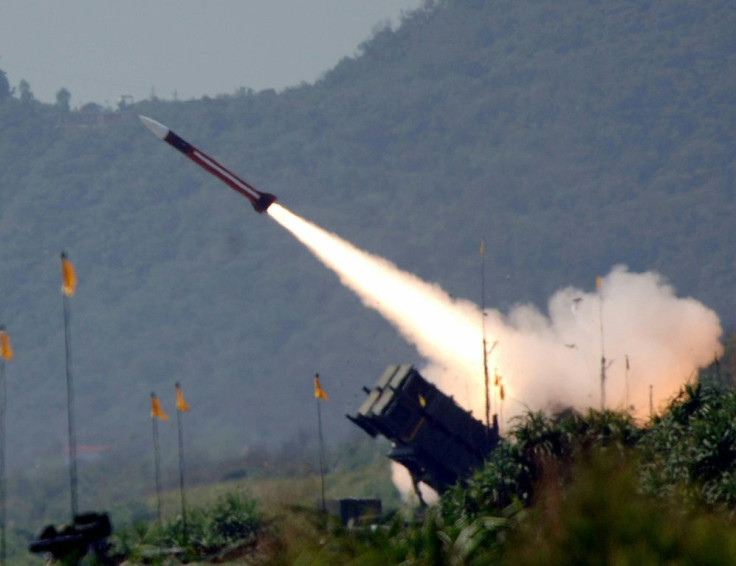Taiwan's Missiles Can Threaten Beijing But The Island's Fire Power Is No Match For China
KEY POINTS
- The island's strongest weapon is the Yun Feng missile, which can reach Beijing
- The Hsiung Sheng missile can strike the bases under China's Eastern Command
- However, Taiwan still continues to be outgunned by China's vastly superior firepower
Taiwan has struck a defiant tone even as China put up a fearsome display of its firepower around the island democracy, casting itself as the David taking on Biblical Goliath. It also teed off a series of war games of its own, showing off its own firepower and some advanced weapons.
All that has made for some great headlines and, alongside Ukraine's success in halting the Russian invasion in its tracks, made many feel the democracies of the world have two of the world's "evil" autocracies cowering at gunpoint. But there is a question here many are willing to ignore: Can Taiwan fend off a Chinese military invasion -- realistically?
The island spends big on defense — a record annual defense budget of about $17 billion for 2022 — and boasts of a strong missile program, which is considered a deterrent to any Chinese invasion plan.
Besides acquiring advanced F-16 fighter jets and M1A2 Abrams tanks for its air force and ground troops, Taiwan has also made steady arms deals with its most important ally, the U.S. Two months ago, Taipei and Washington signed a $108-million arms sale pact, which will further boost its defense.
But the highlight of Taiwan's force is its missile program. According to the Washington-based think tank Center for Strategic and International Studies (CSIS), Taiwan, for decades, limited the composition of its missile forces to defensive assets, such as anti-ship cruise missiles and short-range ballistic missiles. However, it has now shifted the game, deploying and developing missiles suited for strike missions, including longer-range, land-attack cruise missiles.
They include the Hsiung Feng II and Hsiung Feng III, the anti-ship and land attack missiles, with 120 and 150 km range, respectively. The missiles can reportedly reach the mainland to hit Chinese command-and-control centers and supply depots.
Then there is the Hsiung Sheng cruise missile, with an estimated range of 1,000 km to 1,200 km — enough to hit deep inside China. Chieh Chung, a military analyst at the National Policy Foundation in Taipei, told the Indo-Pacific Defense Forum in May that the Hsiung Sheng could hit most bases under the PLA's Eastern Theater Command. This could include installations in Shanghai and Zhejiang provinces, as well as in the north of Qingdao.
As for its Sky Bow-III surface-to-air missile, they can target enemy cruise missiles and drones and knock them out of the sky, according to Sandboxx, a military website.
A good map showing the range of #Taiwan's surface-to-surface missiles, and the locations of important targets in the #Chinese mainland.
— Indo-Pacific News - Watching the CCP-China Threat (@IndoPac_Info) August 16, 2022
Air launched missiles and anti ship missiles are not included. pic.twitter.com/v42tSGVens
However, the most powerful weapon in Taiwan's armory is the Yun Feng, or Cloud Peak, missile. This medium-range supersonic cruise missile with a range of 2,000 km and 500 pounds of armor-piercing high-fragmentation warhead can hit Beijing. Taiwanese leaders have not been shy about highlighting this fact either. Taiwan Legislative Speaker You Si-Kun recently warned China to "think twice" as its Yun Feng could reach Beijing.
Still, these missiles aren't enough to alter the real military balance in the Taiwan Strait. Taiwan still continues to be outgunned by China's firepower. With PLA's strength of 1.04 million troops, of which 416,000 are stationed in the Taiwan Strait, it would be next to impossible for Taiwan to knock China out of any conflict by itself.
That is an important nuance. Taiwan will need active U.S. military support to halt a Chinese invasion, but then Beijing has prepared for years to deny the U.S. the ability to rush to aid its ally.
Beijing's missiles are built to serve its anti-access/area denial doctrine, using a combination of ballistic and cruise missiles like the DF-16 and DF-21 that can target U.S. and U.S. allied military assets in the Asia-Pacific theater. Besides that, China's nuclear arsenal seems to be growing and the PLA's determination to become a modern and first-rate force would likely render Taiwan practically defenseless in the event of a conflict.
China's missile forces are also among the most powerful in the world, with an array of short-range and long-range missiles that can strike any target. Any conflict with Taiwan could see missiles raining on the island's defenses, overwhelming any defense that Taiwan or any other adversary can bring to bear.
Though the PLA's land army is the world's largest standing ground force with 915,000 active-duty troops, they were using outdated equipment and technology until recently. But, that changed as President Xi Jinping embarked on a mission to modernize the PLA, switching to more powerful automated weapons and replacing physical labor with technology.
The PLA Air Force would also bring thousands of aircraft, including the advanced "Mighty Dragon" J-20 and stealth bomber H-20 to the Taiwan Strait. As for naval power, China has a huge numerical advantage, including its three carriers and 360 warships. According to China watchers, the sheer size of their fleet would benefit PLA in a small battlespace like Taiwan Strait.
Besides, China's nuclear arsenal seems to be growing and the PLA's determination to become a modern and first-rate force would likely render Taiwan practically defenseless in the event of a conflict.

© Copyright IBTimes 2024. All rights reserved.





















